
|
Sale 51
Pre-Long Beach Coin and Currency Auction
| Lot |
Photo |
Description |
Realized |
Lot 1777 |
 |
Christopher Bechtler, $2.50 GEORGIA, 64 gr. 22 carats. PCGS graded Genuine. Our grade is Sharpness of Mint State 60+, burnished and cleaned.
Among the most widely respected territorial mints in U.S. history, the Bechtler operation produced coins for nearly 20 years. A relatively large total of $2 million worth of coins were delivered, and, when assayed by the United States Mint, were found to be of the proper weight and fineness. An attractive survivor from the sixth series of Bechtler production, this originally preserved and lustrous golden-brown private Quarter Eagle has only one relevant mark, a diagonal pinscratch beneath the 5 in the denomination. The dies are rotated 90 degrees, the obverse displays three radial die cracks (PCGS # 10073) .
Estimated Value $5,000 - 5,500.
View details and enlarged photos
Check results on similar lots
| Unsold |
Lot 1778 |
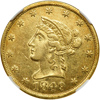 |
1849 Moffat & Co. (San Francisco) TEN DOL. NGC graded AU-58 Star. Well struck and an outstanding example of this notorious problem plagued issue. The surfaces are alive with luster and a hint of light golden toning further adds to its appeal. A very choice example and a Premium Quality coin for the given grade. For the Territorial specialist, this coin represents a challenge to find at all, and is much more difficult to find so choice. An opportunity that no one should take lightly. In a new 4 prong holder. Recently added to the NGC population report. NGC Pop 1, none finer. (A PCGS MS62 appeared in a May 2001 Heritage sale where it was described as a "Possible Specimen Striking.").
Die characteristics: Moffat tens of this type are usually found weakly struck and most are heavily worn. Liberty's hair detail is nearly always indistinct. Personal inspection will quickly inform the viewer that this specimen is extraordinarily detailed.
Estimated Value $25,000 - 30,000.
View details and enlarged photos
| Unsold |
Lot 1779 |
 |
1851 U.S. Assay Office $50 "slug", 880 THOUS. Reeded edge. NGC graded Humbert AU-53. Light golden toning. A sparkling and lustrous specimen in high grade, with very choice surfaces all around and nicely defined design features. The burst of varying golden hues on both sides shows extensive areas of mint frostiness. The eight corners are especially nice as they are free from knocks.
The $50 octagonal "slug," was a golden bastion of California commerce during the first years of Statehood. Such pieces were used in large transactions, being the coin of choice, since the locals were repulsed by "paper" money. (Paper money was made illegal in the state under the Constitution of 1850.)
The octagonal $50 slugs were last made in 1852, after which the Assay Office closed; but the slugs themselves continued in use for many years thereafter. Often, they found their way to the various federal mints, where they were melted into bullion, then refashioned into federal denominations. Pop 12; 34 finer. (PCGS # 10211) .
When the Gold Rush began, California was a peculiarly lawless place. On the day when gold was discovered in 1848 at Sutter's Mill, California was still technically part of Mexico, under American military occupation as the result of the Mexican-American War. With the signing of the treaty ending the war on February 2, 1848, California became a possession of the United States, but it was not a formal "territory" and did not become a state until September 9, 1850.
Estimated Value $32,000 - 35,000.
View details and enlarged photos
Check results on similar lots
| Realized
$28,750 |
Lot 1780 |
 |
1851 U.S. Assay Office-Humbert $50 "slug", 880 THOUS. Reeded edge. PCGS graded EF-45. Nice details and lightly toned. An historic artifact of the California Gold Rush with a few light edge knocks (as typical), reddish toning on both sides around the devices. Nearly fully struck, with just a hint of weakness at OF GOLD on the obverse; bold, clear date. There are several chattermarks on the eagle and in the nearby field.
The U.S. Assay Office would produce what became the highest denomination U.S. gold coin to circulate -- octagonal-shaped $50 gold coin-ingots, often referred to as "slugs." Pop 17; 23 finer. (PCGS # 10211) .
Estimated Value $27,000 - 28,000.
View details and enlarged photos
Check results on similar lots
| Realized
$23,575 |
Lot 1781 |
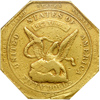 |
1851 U.S. Assay Office $50 "slug", 887 THOUS. Reeded edge. NGC graded Humbert EF-45. An desirable, if somewhat abraded example with light yellow-golden color partial effacement (through wear and otherwise) of the lower legend on the obverse. Three of the four digits in the date are clear; there is an injury to the surface through the date.
This piece, as a "common" Type with 887 THOUS fineness on the scroll, has the familiar Target reverse. The design appears as a series of concentric circles in the center, surrounded by a series of crossing wavy, concentric circles. These concentric circular lines are known to mechanics as "engine turning,", the design is similar to the web-like engraving in the vignettes on paper money or on watchcases. Pop 11 (PCGS # 10214) .
Gold rush anecdote: Bumper-to-bumper highway congestion isn't just a modern phenomena. Rush hour traffic on the Oregon-California trail during 1849 and well into the 1850s was just as bad --probably worse. The image of a lone wagon on the endless prairie is largely myth; it's more accurate to imagine a moving city. Many reported seeing wagons all the way to the horizon day after day bringing miners or their families to the region to get rich in the California gold fields.
Not every 49er used the Oregon -California Trail. There were other routes to gold country -- one came perilously close to Antarctica! Those who did not want to endure a four month trek across the continent, traveled to California by ship. Trouble was, there was no direct water route to the west coast. So a ship leaving an East Coast city had to travel all the way to the tip of South America -- skirting the edge of the the Antarctic continent -- before heading north to California. It was a difficult trip that sometimes took a complete year.
Estimated Value $27,000 - 28,000.
View details and enlarged photos
Check results on similar lots
| Unsold |
Lot 1782 |
 |
1852 Moffat & Co. (San Francisco) TEN DOLS. NGC graded MS-61. 884 THOUS. Well struck and untoned. A highly lustrous Mint State with a nuance of brilliance throughout, no toning on both sides, all of which is underpinned by nice satin freshness. Struck from typically-rusted dies that imported a coarse texture to the obverse field.
The coins of Moffat and Co. struck between 1849 and 1852 were renowned at the time for their fine quality and rigorous adherence to standard weight and fineness. Their consistency earned them the government contract as the U.S. Assay Office of Gold in early 1852. Some have said of the designs, they were competent but not beautiful, and today most gold pieces bearing the imprint of the firm show circulation wear and the usual abrasions associated with use. Any high-grade example would have survived only on the off-chance to the present day, which is why we eagerly recommend this attractive Mint State to you. Pop 1; 1 in 62 (PCGS # 10187) .
Estimated Value $18,000 - 20,000.
View details and enlarged photos
Check results on similar lots
| Unsold |
Lot 1783 |
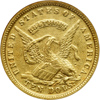 |
1852 U.S. Assay Office $10 Gold, 884 THOUS. NGC graded AU-58. Nice untoned example. A high degree of luster distinguishes the satiny, albeit somewhat granular golden surfaces from others of the date which are less frosty even though in technically similar grade. Collectors familiar with the series will recognize this difference at once. The 884 THOUS type of Assay Office $10 is traditionally been ascribed to the "scarce" or "rare" category, and for obvious reasons. Once the U.S. Mint in San Francisco opened for coining in 1854, almost the entire earlier production of Assay Office coins, along with Humbert's territorials, were recoined into federal coinage. A wonderful opportunity for the specialist in this series to acquire a high grade specimen. Pop 24; 41 finer; 6 in 60; 23 in 61; 9 in 62; 3 in 64. (PCGS # 10001) .
Estimated Value $9,000 - 10,000.
View details and enlarged photos
Check results on similar lots
| Unsold |
Lot 1784 |
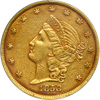 |
1853 U.S. Assay Office - Moffat $20 Gold Eagle. PCGS graded AU-53. Toned on both sides with some lilac colors around the edges. While not the first private coining establishment, Moffat & Co. was by far the most prolific in the first period of California private gold minting. It enjoyed the highest reputation of all the coining companies, affirmed by the Federal Government when it asked the two surviving members of the firm to initiate the United States Branch Mint in San Francisco. Pop 7; 10 finer; 7 in 55; 2 in 58; 1 in 61. (PCGS # 10255) .
Estimated Value $12,000 - 13,000.
View details and enlarged photos
Check results on similar lots
| Realized
$12,075 |
Lot 1785 |
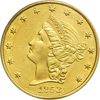 |
1853 U.S. Assay Office $20 Gold Eagle. PCGS graded Genuine. Our grade is Sharpness of MS-60+, cleaned and burnished. To the naked eye, looks like a frosty BU coin and collectors will enjoy examining its fine craftsmanship while recalling the conditions under which it came into existence. A classic from the California gold rush days (PCGS # 10255) .
Estimated Value $4,500 - 5,000.
View details and enlarged photos
Check results on similar lots
| Realized
$4,198 |
Lot 1786 |
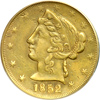 |
1852 Wass, Molitor & Co. (San Francisco) $5 Gold. Large head. PCGS graded Genuine. Our grade is Sharpness of EF-40, cleaned long ago. Toned to a natural looking olive-gold. Yellow gold color underlies this with some hairlines from the cleaning but acceptable eye appeal overall. Evenly struck with good definition of the finer details, in fact, struck about as one might expect from a private issue of the gold rush days (PCGS # 10342) .
Estimated Value $4,000 - 4,500.
View details and enlarged photos
Check results on similar lots
| Realized
$5,750 |
Lot 1787 |
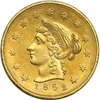 |
1852 Wass, Molitor & Co. (San Francisco) $10 Gold. Large head. PCGS graded AU-55. Lovely golden toning. Lustrous satiny golden orange surfaces with rich champagne highlights. Nearly full hair and eagle detail, we note a single chattermark on the jaw near the ear. A truly beautiful AU55 specimen of a much scarcer Territorial mint issue from our California pioneer heritage.
According to the Kagin reference on this series (which no Territorial specialist should be without), "Evidently the reverse dies were obtained from Dubosq & Co. as they appear to be identical. Moffat & Co., operating for the United States Assay Office, also coined issues in 1852. Evidently these issues filled the monetary needs of the area for some time as no Wass, Molitor & Co. coins were struck bearing 1853 or 1854 dates." Pop 5; 4 finer, 1 in 58, 1 in 60, 2 in 62 (PCGS # 10348) .
Estimated Value $12,000 - 14,000.
Ex: Al Blythe Collection.
View details and enlarged photos
Check results on similar lots
| Realized
$10,925 |
Lot 1788 |
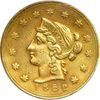 |
1852 Wass, Molitor & Co. (San Francisco) $10 Gold. Large head. PCGS graded VF-30. Struck with a nice deep obverse impression giving the coin a somewhat convex appearance. We note some tiny marks about the rims with is quite normal for this rare issue, all delicately toned. These rare territorial pieces are usually encountered in Very Fine to Extremely Fine condition at best. So, it is not usually possible to see just how this case of crude die cutting actually looks (PCGS # 10348) .
Estimated Value $5,000 - 5,500.
View details and enlarged photos
Check results on similar lots
| Realized
$4,025 |
Lot 1789 |
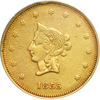 |
1855 Wass, Molitor & Co. (San Francisco) $20 Gold. Small head. PCGS graded VF-35 PQ. Lovely golden toning. This is the extremely elusive Small Head $20 denomination, a coin much in demand because it appears in the Red Book, but one whose auction appearances confirm the true scope of its rarity in all grades. The present example displays light and lively golden surfaces with toning at the border and (for the type) a bold strike. W.M.&Co appears on the coronet. Most hair curls including those at the ear and brow plainly visible. Rims choice with only one tiny bruise at the upper obverse edge. The eagle shows slightly less detail than the Liberty head, but the shield is complete in outline with some of the stripes still evident. Bold legends, date and stars. Everything you would want from the grade, and probably then some. Only 18 coins graded for the type at PCGS (PCGS # 10357) .
According to the Dr. Donald Kagin reference on Territorial Gold pieces, "Count Samuel C. Wass and Agoston P. Molitor were Hungarian compatriots during their native country's war for independence. Both had acquired considerable practical knowledge of mining and all its ramifications at the celebrated School of Mines of Germany, and they had subsequently worked the mines in Hungary before they were exiled by the Austrians. Wass emigrated to California in October 1850; Molitor in 1851, having traveled there via London.
"Upon arriving in California, Wass spent three months exploring the mines of the gold regions. The detailed report of his findings was published in the Alta California in January 1851…"
Their first isues of gold coins consisting of $5 and $10 denominations, was made in 1852.
During 1854 and 1855, the United States Branch Mint at San Francisco was forced to close intermittently for lack of proper acids to refine gold dust and copper alloy. During a particularly long layoff of coining operations in March 1855, a group of prominent bankers petitioned Wass, Molitor & Co. to supply the city with gold coins once more. Coinage commenced using 1855-dated dies and the firm subsequently issued $10, $20 and $50 coins.
Estimated Value $30,000 - 35,000.
View details and enlarged photos
Check results on similar lots
| Unsold |
Lot 1790 |
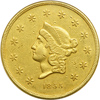 |
1855 Wass, Molitor & Co. (San Francisco) $50 Gold. NGC graded AU-58. An excellent example for the grade and free from the heavy digs and rim bruses that usually accompany this massive round coin. This historic and nicely preserved AU58 $50 gold piece has rare beauty that comes with fully defined design features plus a strict limitation on surface marks. What's more, the rims are choicer than average for what is often a bunged-about Type, wherein use in circulation tended to damage the soft rim areas. While the octagonal fifties from the Assay Office get much of the news reportage in the American numismatic press, that is only because they are seen ten times more often than a Wass $50 piece.
The firm of Wass, Molitor & Company was comprised of Samuel Wass and Agoston Molitor, who operated their well-respected private mint in the Bay area from 1852. Their first deliveries consisted of five- and ten-dollar gold pieces for local use. They ceased minting when the San Francisco Mint opened in 1854, but resumed with production of the famous $50 denomination round gold coins in 1855. This was at a time when the federal facility was obliged to close from time to time for lack of proper parting acids to refine gold dust with the requisite copper alloy. The fifty dollar Wass, Molitor pieces filled the void at this critical time. Reports are the Wass Molitor coinage had one of the highest intrinsic values of any of the private issues in California. Many were subsequently melted. Pop 2; 8 finer (PCGS # 10363) .
According to Dr. Donald Kagin, "Wass, Molitor & Co. closed down their operation soon after the 1855 issues were distributed, for the 1856-1857 San Francisco Directory lists the assaying firm of Wass (Karoly) Usznay & Co. as operating during 1856 and 1857. Haraszthy replaced Molitor as partner in this firm, as the latter had left California for London in 1856." Dr. Kagin's book "Private Gold Coins and Patterns of the United States," gives an detailed account of the Territorial issues, including a full description of the Wass, Molitor company and its gold coins.
Estimated Value $75,000 - 85,000.
View details and enlarged photos
Check results on similar lots
| Unsold |
Lot 1791 |
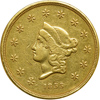 |
1855 Wass, Molitor & Co. (San Francisco) $50 Gold. NGC graded AU-53. A very pleasing example of this huge massive "Slug" with far fewer rim bumps than usually seen. Some scattered marks in the unprotected fields, one near the nose and below the chin, neither of which are too serious and all is commensurate with the grade given. Easily worth our conservative estimate. An historic and nicely preserved $50 gold piece whose rare beauty comes with fully defined design features plus a strict limitation on surface marks. What's more, the rims are choicer than average for this often bunged-about Type, wherein use in circulation tended to damage the soft rim areas. While the octagonal fifties from the Assay Office get much of the news coverage in the American numismatic press, that is only because they are seen ten times as often as a Wass $50 piece.
The firm of Wass, Molitor & Company was comprised of Samuel Wass and Agoston Molitor, who operated their well-respected private mint in the Bay area from 1852. Their first deliveries consisted of five- and ten-dollar gold pieces for local use. They ceased minting when the San Francisco Mint opened in 1854, but resumed with production of the famous $50 denomination round gold coins in 1855. This was at a time when the federal facility was obliged to close from time to time for lack of proper parting acids to refine gold dust with the requisite copper alloy. The fifty dollar Wass, Molitor pieces filled the void at this critical time. Reports are the Wass Molitor coinage had one of the highest intrinsic values of any of the private issues in California. Many were subsequently melted. Pop 3; 14 finer.
Estimated Value $65,000 - 70,000.
View details and enlarged photos
| Unsold |
Lot 1792 |
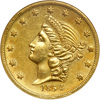 |
1854 Kellogg & Co. (San Francisco) $20 Gold. NGC graded MS-61. Well struck with light gold toning. Fully pulsating with lovely vivid color, the surfaces are free of bothersome striking incompleteness. Struck with exactitude by the dies. This is seen in the outstanding hair waves on Liberty, a full coronet (inscribed KELLOGG & CO.), and simply bold detail on the eagle and rays above. A few of the obverse stars are flat, that is all. One of the handsomer appearing Territorial issues.
When the U.S. Assay Office of Gold ceased operation, John Glover Kellogg and his partner G.F. Richter, earlier an assayer with the U.S. Assay Office of Gold, opened the Kellogg & Richter firm, doing business as Kellogg & Co. In January 1854 numerous leading banks petitioned Kellogg & Richter, pleading with them to produce gold coins until the new Mint opened. Kellogg & Co. began coining private-issue twenty dollar gold pieces in February of that year. These resembled the federal design. Kellogg claimed that his firm could issue $20,000 worth per day. Most were later withdrawn from circulation and melted at the nearby San Francisco Mint when it opened for operations. Pop 12; 4 finer; 2 in 62; 1 in 63; 1 in 66.
Estimated Value $15,000 - 16,000.
View details and enlarged photos
| Unsold |
Lot 1793 |
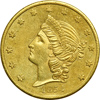 |
1854 Kellogg & Co. (San Francisco) $20 Gold. NGC graded MS-60. Well struck and lightly toned. A satiny specimen of this handsome Kellogg Territorial. Supple underlying luster is enveloped in pale toning iridescence. A pleasing example of the date, indeed, because of the lack of marks and surface deterioration, an impressive one as well. Thoroughly struck on the main devices (Liberty and eagle), but with sufficient detail in the stars at the top to call them all full (this is nitpicking, however, in such an important gold coin). The most notable marks we can find is a small dash line at Liberty's eyebrow. And there are a few scuffs within the circle of stars on the reverse. A couple of tiny rim marks above FRANCISCO on the reverse. All in all a splendid looking coin for the collector. Pop 7; 11 finer, 8 in 61, 3 in 62.
Estimated Value $12,000 - 14,000.
Ex: Al Blythe Collection.
View details and enlarged photos
| Realized
$12,075 |
Lot 1794 |
 |
1855 Kellogg & Co. (San Francisco) $50 Gold Round Commerative Restrike PCGS graded Gem Proof. Struck from S. S. Central America gold Kellogg Bars. Struck Sept. 1, 2001.
Estimated Value $2,500 - 3,000.
View details and enlarged photos
| Realized
$2,645 |
Lot 1795 |
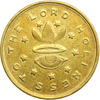 |
1850 Mormon $5 Gold. PCGS graded AU-55. Attractive golden toning on both sides. The Mormon gold coins of 1849-50 were of superior quality despite the poor equipment they had available to produce them. The coins were all struck using a uniform system of determining weight and fineness. However, due to the softness of the pure gold, the first coins issued quickly showed signs of significant wear. In batches of coins to follow, a small percentage of silver was added to create an alloy, and thus, more durable corns.
The Mormon gold coins were struck mainly so the people within the settlement would have a sound means of exchange to purchase goods produced back East, in the industrial portion of the country. However, some were also traded to the few non-Mormon businesses located in Utah. Because most of the coins were shipped East, there were virtually none left in circulation in the Mormon local market.
This carefully preserved About Uncirculated example is one of the choicest around. A high degree of smooth surface originality expands broadly beneath the shades of warm golden color with its orange accents. Nicely struck with outstanding detail at the eye as well as in the clasped hands. Only light circulation signs from the short time it was used in commercial transactions. Pop 11; 2 finer, 1 in 58, 1 in 61 (PCGS # 10265) .
Estimated Value $30,000 - 35,000.
Ex: Al Blythe Collection.
View details and enlarged photos
Check results on similar lots
| Realized
$41,400 |
Lot 1796 |
 |
1861 Clark, Gruber & Co. (Denver, Colorado) $5 Gold. PCGS graded AU-58. A triflely softly struck in the centers with plenty of mint luster intact. A touch of lovely golden toning adds to its appeal. A satiny example of this elusive Colorado Pioneer or Territorial issue with dynamic luster within the devices and choice surfaces far afield from the normal scruffy look of these rare $5 gold pieces. Would take years to locate a choicer looking AU58 specimen. In an old green label holder.
The firm of Clark, Gruber & Co., Leavenworth, Kansas bankers, established a branch in Denver following discovery of gold deposits in the area in 1859, primarily in the mountains to the west. In time, the firm grew to become Colorado's largest mint, an operation which subsequently laid the foundation for the government mint in the same city. Partners were Austin M. Clark, Milton Edward Clark, and Emanuel Henry Gruber.
Struck in what was known as the Jefferson Territory (Colorado) in very limited quantities. Experts quote the mintage at about 6,920, but as with other Pioneer gold coins, many saw extensive circulation and many were melted and turned into federal gold coinage. On April 16, 1863 the federal government purchased the Clark-Gruber & Co. firm with all of its equipment which eventually became the Denver mint. Pop 5; 2 in 62, 2 in 63 (PCGS # 10140) .
Estimated Value $20,000 - 22,000.
View details and enlarged photos
Check results on similar lots
| Unsold |
|
|